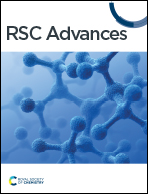Tunable ohmic van der Waals-type contacts in monolayer C3N field-effect transistors†
Abstract
Monolayer (ML) C3N, a novel two-dimensional flat crystalline material with a suitable bandgap and excellent carrier mobility, is a prospective channel material candidate for next-generation field-effect transistors (FETs). The contact properties of ML C3N–metal interfaces based on FETs have been comprehensively investigated with metal electrodes (graphene, Ti2C(OH/F)2, Zr2C(OH/F)2, Au, Ni, Pd, and Pt) by employing ab initio electronic structure calculations and quantum transport simulations. The contact properties of ML C3N are isotropic along the armchair and zigzag directions except for the case of Au. ML C3N establishes vertical van der Waals-type ohmic contacts with all the calculated metals except for Zr2CF2. The ML C3N–graphene, –Zr2CF2, –Ti2CF2, –Pt, –Pd, and –Ni interfaces form p-type lateral ohmic contacts, while the ML C3N–Ti2C(OH)2 and –Zr2C(OH)2 interfaces form n-type lateral ohmic contacts. The ohmic contact polarity can be regulated by changing the functional groups of the 2D MXene electrodes. These results provide theoretical insights into the characteristics of ML C3N–metal interfaces, which are important for choosing suitable electrodes and the design of ML C3N devices.



 Please wait while we load your content...
Please wait while we load your content...